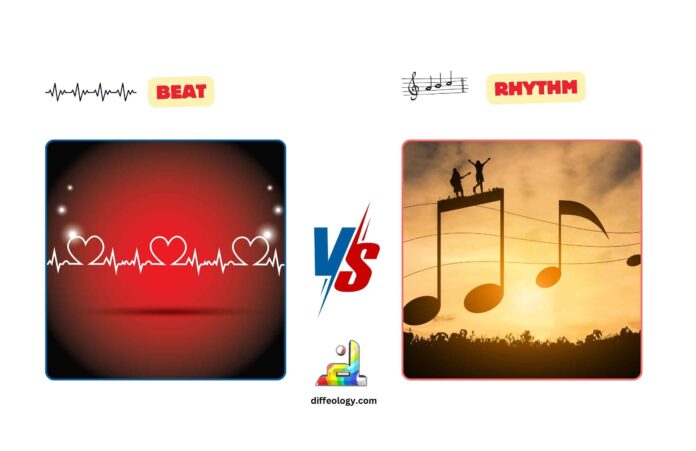While music certainly contains many different elements, two of the most important are beat and rhythm. These two parts of a song combine to create the sound we hear. The Difference Between Beat and Rhythm is simple. The beat is the steady pulse one taps to. Rhythm is the pattern of sounds and silences that happens over the beat. Every song has a beat, but the rhythm may differ from one song to another. The two elements are essential in coming up with the various styles of music, be it pop or jazz. Although they seem comparable, knowing the difference helps us enjoy music more.
Main Difference Between Beat and Rhythm
A beat is basically the most simple unit of all music. It may sound elementary in the making, but rhythm can add variety and life by changing how long the notes or silences last. Beats are regular and steady; it is like a clock that is ticking. On the other hand, rhythm will change and vary to give different feels. The musicians count beats as 1-2-3-4 endlessly.
Rhythm does not always proceed, as this could be fast or slow on those counts. When you tap your foot to music, you feel the beat. And when you clap to the words or the melody in a song, you follow the rhythm. It is the beat that ties music together, giving it shape. Rhythm gives the music unique patterns, which make it interesting.
Beat Vs. Rhythm
What is a Beat?
In music, a beat is like the heart pumping. It’s the repeating, regular pulse that helps you feel the rhythm. You can almost think of it as a clock ticking or your heartbeat. It’s like they’re telling you when to clap your hands or tap your feet. The beat is well-paced and keeps the steady rhythm going, so it is easy to follow. When you listen to a song and nod to the music, that’s the beat. For example, if the song is fast, you might be feeling excited or energetic. If the beat is slow, you might be feeling relaxed.
Read Also: Difference Between Poem and Poetry
There are different kinds of beats in the music. For example, 6/8 time signature is very common in children’s songs where there are six beats in each measure and every beat is an eighth note [1]. Musicians and dancers base their moves according to beats. A band would mostly have a drummer play the beat and other instruments would follow along with it. Rhythm determines the sort of elaborate rhythms to be used with melodies and harmonies to make the music sound good and organized.
What Is a Rhythm?
Rhythm is the musical pattern of sounds and silences that occur over time. It indicates how long or short each note should last and where you should play or stop. It also governs the beat or pulse, which can be rapid, slow, or modulated throughout the piece. For instance, if you find yourself tapping your foot to a song, you’re actually following the rhythm of that song. It allows musicians to keep time and gives shape to where the melodies and harmonies will sit. Without rhythm, music would be just sounds hurled one after the other.
Read Also: Difference Between EarPods and AirPods
Rhythm is usually divided into repeating units, also called measures or bars. A measure is further broken down into smaller units of beats, and the beats are either strong, unstressed, or weak. The emotions in songs differ due to the varied kinds of rhythms, from steady to simple, like in a march, and to complex and syncopated, as in jazz. Rhythm is one of the most powerful aspects of music, which makes it seem vibrant and gives it life.
Comparison Table “Beat Vs. Rhythm”
| Importance | Forms the base | Adds character |
| Role | Keeps time | Adds variety and shape |
| Complexity | Simple | Can be complex |
| Speed | Same tempo throughout | Can be fast or slow |
| Control | Usually consistent | Can be irregular |
| Main idea | Constant, regular | Can change, flow |
| Pattern | Repeats in a loop | Changes frequently |
| Foundation | Basic structure | Creative expression |
| Music genre | Used in all types of music | Especially noticed in classical & jazz |
| Sound | Can exist with no sound (tap) | Exists with a mix of sounds and rests |
| Flow | Unchanging | Flexible |
| Relation | Acts like a guide | Follows or plays around with the beat |
| Origin | Fixed, predictable | Free-flowing |
| Focus | Helps with timing | Helps with feeling |
| Feel | Like a heartbeat | Like words in a sentence |
| Human link | Mirrors heartbeat | Mirrors language, conversation |
| Definition | Steady pulse | Pattern of sounds and silences |
| Example | Ticking clock | Song melody |
| Timing | Equal intervals | Varies |
| Instruments | Drums, metronome | Voice, instruments, anything |
| Interaction | Base for rhythm to build on | Works with the beat |
Difference Between Beat and Rhythm in Detail
Get to know the Difference Between Beat Vs. Rhythm in Detail.
Basic Definition of Beat and Rhythm
A beat is the steady pulse you can feel in a song. It’s kind of like a clock ticking or a heartbeat. Beats occur at equal intervals. You can tap your foot to the beat of most songs.
Rhythm is just the way that sounds and silences are ordered. It is the way the notes appear in time. Rhythm can change or be of varied length. It may coincide with the beat, or it can go against the beat. Rhythm makes the music interesting.
How Beat and Rhythm Work Together
Be like the backbone of music. Without beats, it is hard to stay in line. Musicians count their beats to keep them together. For instance, in 4/4 time, there are four beats in every measure.
Rhythm dances around the beat. Think of rhythm as a melody or the words that float above the beat. Even with a steady beat, the rhythm can change. That is why a song sounds alive and not mechanical.
Nature Steady vs. Changing
A beat is often steady. This means it doesn’t change much unless the tempo (speed) changes. In most pop and rock songs, the beat stays the same throughout the entire song.
Rhythm is flexible. It changes throughout the song. Different parts of a song can have different rhythms. The drums, guitar, and vocals often play different rhythms at the same time. This adds richness to the music.
Measuring Beat and Rhythm
The beat is measured in beats per minute (BPM). This shows you whether the beat is fast, slow, slow-fast, or slow-slow. For example, if a song is recorded at 120 BPM, it will be very fast. If a song is recorded at 60 BPM, then you might be likely to hear a ballad.
The duration of each note or rest determines the rhythm. Musicians make use of whole notes, half notes, quarter notes, and this goes on and on. Silence is also part of rhythm. This silence is called rests and rests are required to break the intensity of sounds.
Instruments That Emphasize Beat and Rhythm
The drums and bass are the instruments that commonly play out the beat. The drummer often decides the tempo of the song that he and the other instruments maintain throughout. The bass helps anchor the song by playing along with the strong beats.
Melody instruments like guitars, pianos, and voices use different note lengths and times to create restful places in a line of notes or pitches to create patterns called rhythm. For example, a singer might let one note ring out just a little longer than another, creating that sense of rhythm in the melody.
Beat and Rhythm: An Imaginative Exercise
Imagine a row of evenly-spaced dots. There are no variations in the distance between them. They just keep going.
However, rhythm possesses the visual characteristic of a pattern that is made up of both short and long lines. Some of the lines appear next to each other, while others are far away. The rhythm assists in breaking the pattern of the strong beats, hence providing diversity.
Beat and Rhythm in Dance and Life
In dance, beat basically means what keeps the dancers in time. They rely on the uniform pulse to make their moves harmonic. In fact, such patterns of beats have been created for too many various forms of dances, such as salsa or hip-hop.
Rhythm in dance is the movement between the beats. Dancers would use rhythm for flavor and expression. In life, rhythm is seen almost all the time, like your walking speed or how fluently you are speaking. This keeps things going and interesting.
Key Points Presenting the Difference Between Beat and Rhythm
Basic Meaning
The beat is the steady pulse in the music, like your heart beating. Rhythm is the pattern of sounds and silences, like footsteps following the beat.
Speed
The beat stays at the same speed or tempo throughout the song. Rhythm can speed up or slow down within the song.
Simple vs. Complex
Beats are simple and predictable. Rhythm can be simple or very complex, with different note lengths and rests.
Instruments
Drums often emphasize the beat. Other instruments, like the guitar or piano, focus more on rhythm.
Connection to Dance
Dancers usually move to the beat. Their movements might also follow the rhythm to match the song’s energy.
Feel in a Song
A song’s beat is like a heartbeat, constant and reliable. Rhythm can change how a song feels—happy, sad, fast, or slow.
Music Genres
In many pop or rock songs, the beat is easy to hear. In jazz or classical music, the rhythm often changes a lot and may be harder to follow.
Examples
A beat is like walking in time with a metronome. Rhythm is like walking in patterns—sometimes fast, sometimes slow.
Beat’s Role in Groups
In a band or group, everyone follows the beat to stay together. Rhythm lets individual players add personal style.
How They Work Together
The beat keeps everything in sync. Rhythm adds creativity and expression to the music.
Tapping vs. Playing
You can tap your foot to a beat without needing to understand the music. Rhythm requires knowing when to play and for how long.
Important in Learning
Learning the beat helps beginners stay on time. Learning rhythm takes practice to get the timing just right.
FAQs: Beat Vs. Rhythm
Conclusion
In simple words, the beat is somewhere like the heart of the song that beats with its constant pulse. Rhythm, however, brings variety and creativity into the same song. If there is no beat, the music will be all over, but if there is no rhythm, it will be dull. When combined, beat and rhythm provide energy and flow to the music, which engages the listeners. Recognizing these two elements helps us appreciate music better and identify the exact reason why songs make us feel a certain way. Now, when you play the music, you know the Difference Between Beat and Rhythm.
References & External Links
- Top 10 Beats Every Music Producer Should Know
- The Extraordinary Ways Rhythm Shapes Our Lives



